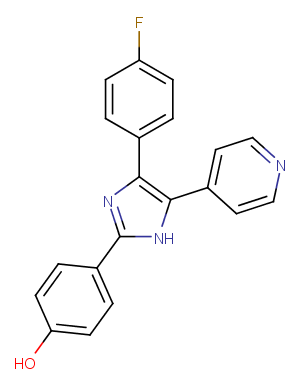产品信息
SB 202190 is a selective and cell-permeable inhibitor of p38 MAPK (IC50s: 50/100 nM for p38α/p38β).
|
CAS号
|
152121-30-7 |
| 分子式 |
C20H14FN3O |
| 主要靶点 |
Apoptosis|p38 MAPK|Autophagy |
| 主要通路 |
自噬|MAPK信号通路|凋亡 |
| 分子量 |
331.34 |
| 纯度 |
99.67%, 此纯度可做参考,具体纯度与批次有关系,可咨询客服 |
| 储存条件 |
Powder: -20°C for 3 years | In solvent: -80°C for 1 year |
| 别名 |
FHPI|SB202190 |
靶点活性
p38α:50 nM (cell free)|p38β:100 nM (cell free)
体内活性
Mice treated with the p38MAPK inhibitor SB202190 and pathogenic PV IgG failed to develop blisters, clinically and histologically. Direct IF of nonlesional skin from both PV IgG and PV IgG plus SB202190 mouse skin demonstrated PV antibodies bound to the epidermal keratinocyte cell surface, indicating that the inhibitor did not prevent or alter the binding of PV autoantibodies to the target organ [4]. Compared to the model group, the SB202190 group exhibited significantly shorter escape latencies in the Morris water maze hidden platform trials and longer times in the original platform quadrant during probe trials. The SB202190 group also showed significantly reduced neuronal apoptosis in the hippocampus compared to VaD model rats as well as higher (antiapoptotic) Bcl-2 expression and lower (proapoptotic) caspase-3 expression [5].
体外活性
SB 202190 inhibited SAPK2a/p38 and SAPK2b/p38β2 with IC50 values of 50 nM and 100 nM respectively [1]. SB202190 inhibited the expression of albumin-induced proinflammatory (monocyte chemoattractant protein-1) and TGF-beta1-induced profibrotic (procollagen-Ialpha1) genes over 50% in renal tubular cells (normal rat kidney-52E) [2]. While using SB202190 to inhibit p38 MAPK-related signaling, it was observed that SB202190 treatment could activate JNK. Treatment of cells with SB202190 could phosphorylate JNK and activating transcription factor 2 (ATF-2) and increased AP-1 DNA binding [3].
溶解度
细胞实验
For transfection, A549 cells were seeded in 6-well plates to obtain 30% confluence at the time of transfection. Xtreme siRNA transfection reagent was used to transfect siRNA to a final concentration of 100 nM. Inhibition of gene expression by siRNA was determined after 48 hours by Western analysis. Cells were harvested, and the nuclear extract or total cell lysate was assayed for AP-1 DNA binding or Western blotting, respectively. HEK293T cells were cultured in complete DMEM. phCMV2-HA-MLK3 was transfected into HEK293T cells using genejammer transfection reagent using manufacturer's instructions. After 48 hours, cells were either untreated or treated with 5 or 10 μM SB202190 or SB203580 for 4 hours. Following treatment cell lysates were prepared using lysis buffer (50 mM Tris-HCl at pH 7.5, 5 mM EDTA, 150 mM NaCl, 1% Triton X-100, 50 mM NaF, 10 mM sodium pyrophosphate, 25 mM β- glycerophosphate, 1 mM PMSF, 30 μL/mL aprotinin, and 1 mM Na3VO4). 500 μg of total protein was immunoprecipitated with anti-HA-agarose conjugate. Phospho-MLK3 (Thr277/Ser281) was detected in western blotting using phosphospecific antibodies. The expression vector was transfected into HEK293T cells using Genejammer as stated earlier. After 48 hours, cell lysates was prepared and Flag-MKK7 was immunoprecipitated using anti-Flag-agarose conjugate. The Flag-MKK7 was used as a substrate for MLK3 kinase assay [3].
动物实验
The pharmacological efficacy of SB-ULS-LZM was evaluated in the unilateral ischemia-reperfusion (I/R) rat model. At 2 h before the ischemia procedure, rats were injected with SB-ULS-LZM (32 mg/kg. conjugate, equivalent to 752 g/kg SB202190), vehicle (5% glucose), or free SB202190 (800 g/kg). SB-ULS-LZM was dissolved in 5% glucose, whereas SB202190 was dissolved in 20% hydroxypropyl-β-cyclodextrin solution with 5% dimethyl sulfoxide as described earlier. Compounds were administered i.v. via the penis vein as described above. Animals were allowed to recover and placed back into the cages until the induction of renal ischemia. Rats were operated, and the renal artery and vein were clamped under microscope to stop renal blood flow. After 45 min, clamps were removed, and reperfusion of the kidney was observed before closing of the wound. Sham-operated animals (n 3) received the same surgical procedure, with the exception of ischemia, and were included as a control group. After 4 days, animals were sacrificed, and blood samples were collected from the abdominal aorta. Kidneys were isolated after gently flushing the organs with saline and preserved in 4% formalin for preparation of paraffin-embedded sections or frozen in ice-cold isopentane for preparation of cryosections [2].

